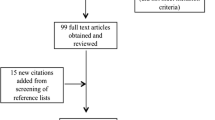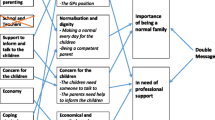Abstract
This qualitative study explores how to improve services for children of parents with Substance Use Disorders (SUD) with unmet mental health needs. Focus groups were conducted with parents and caregivers to identify perceived barriers to services, including: (1) attitudes and beliefs about mental health care, (2) inadequacies in mental health services, (3) children’s ambivalence about treatment, and (4) parental disagreement and lack of involvement. Peer support, afterschool activities, and family counseling were identified as potential improvements. This information can serve as a foundation and guide to develop services for the underserved population of children and adolescents of substance abusing parents.
Similar content being viewed by others
References
Bancroft, A., Wilson, S., Cunningham-Burley, S., Backett-Milburn, K., & Masters, H. (2004). Parental drug and alcohol misuse: Resilience and transition among young people. York, North Yorkshire: Joseph Roundtree Foundation.
Ben-Dror, R. (1994). Employee turnover in community mental health organization: A developmental stages study. Community Mental Health Journal, 30(3), 243–257.
Bernard, H. R. (2000). Social research methods: Qualitative and quantitative approaches. Thousand Oaks, CA: Sage Publications.
Birmaher, B., Brent, D. A., Kolko, D., Baugher, M., Bridge, J., Holder, D., et al. (2000). Clinical outcome after short-term psychotherapy for adolescents with major depressive disorder. Archives of General Psychiatry, 57(1), 29–36.
Carroll, K. M., Libby, B., Sheehan, J., & Hyland, N. (2001). Motivational interviewing to enhance treatment initiation in substance abusers: An effectiveness study. American Journal on Addictions, 10(4), 335–339.
Catalano, R. F., Gainey, R. R., Fleming, C. B., Haggerty, K. P., & Johnson, N. O. (1999). An experimental intervention with families of substance abusers: One-year follow-up of the focus on families project. Addiction, 94(2), 241–254.
Clark, D. B., Moss, H. B., Kirisci, L., Mezzich, A. C., Miles, R., & Ott, P. (1997). Psychopathology in preadolescent sons of fathers with substance use disorders. Journal of the American Academy of Child and Adolescent Psychiatry, 36(4), 495–502.
Cooper-Patrick, L., Brown, C., Palenchar, D., Gonzales, J., & Ford, D. (1995). Factors associated with help-seeking behavior for mental health services (Vol. 12). Baltimore, MD: Johns Hopkins School of Medicine.
Copello, A. G., Velleman, R. D., & Templeton, L. J. (2005). Family interventions in the treatment of alcohol and drug problems. Drug and Alcohol Review, 24(4), 369–385.
Daley, D. C., & Zuckoff, A. (1999). Improving treatment compliance: Counseling and systems strategies for substance abuse and dual disorders. Center City, MN: Hazelden.
Day, C. (2008). Children’s and young people’s involvement and participation in mental health care. Child and Adolescent Mental Health, 13(1), 2–8.
Day, C., Carey, M., & Surgenor, T. (2006). Children’s key concerns: Piloting a qualitative approach to understanding their experience of mental health care. Clinical Child Psychology and Psychiatry, 11(1), 139–155.
Dierker, L. C., Merikangas, K. R., & Szatmari, P. (1999). Influence of parental concordance for psychiatric disorders on psychopathology in offspring. Journal of the American Academy of Child and Adolescent Psychiatry, 38(3), 280–288.
Duncan, B. L., Sparks, J. A., Murphy, J. J., & Miller, S. D. (2007). Just say “no” to drugs as a first treatment for child problems. Psychotherapy in Australia, 13, 32–40.
Fals-Stewart, W., Fincham, F. D., & Kelley, M. L. (2004). Substance-abusing parents’ attitudes toward allowing their custodial children to participate in treatment: A comparison of mothers versus fathers. Journal of Family Psychology, 18(4), 666–671.
Gallon, S. L., Gabriel, R. M., & Knudsen, J. R. (2003). The toughest job you’ll ever love: A pacific northwest treatment workforce survey. Journal of Substance Abuse Treatment, 24(3), 183–196.
Gance-Cleveland, B. (2004). Qualitative evaluation of a school-based support group for adolescents with an addicted parent. Nursing Research, 53(6), 379–386.
Glaser, B. G., & Strauss, A. (1967). The discovery of grounded theory: Strategies for qualitative research. Chicago, IL: Aldine.
Gonzalez, J. M. (2005). Access to mental health services: The struggle of poverty affected urban children of color. Child and Adolescent Social Work Journal, 22(3), 245–256.
Gregg, M. E., & Toumbourou, J. W. (2003). Sibling peer support group for young people with a sibling using drugs: A pilot study. Journal of Psychoactive Drugs, 35(3), 311–319.
Hayes, S. C., Bissett, R., Roget, N., Padilla, M., Kohlenberg, B. S., Fisher, G., et al. (2004). The impact of acceptance and commitment training and multicultural training on the stigmatizing attitudes and professional burnout of substance abuse counselors. Behavior Therapy, 35(4), 821.
Hill, S. Y., & Muka, D. (1996). Childhood psychopathology in children from families of alcoholic female probands. Journal of the American Academy of Child and Adolescent Psychiatry, 35(6), 725–733.
Institute of Medicine Committee on Crossing the Quality Chasm. (2006). Chapter 5. Coordinating care for better mental, substance-use, and general health. In Improving the quality of health care for mental and substance-use conditions (p. 504). Washington, DC: National Academies Press.
Kazdin, A. E. (2003). Psychotherapy for children and adolescents. Annual Review of Psychology, 54, 253–276.
Kelley, M. L., & Fals-Stewart, W. (2002). Couples- versus individual-based therapy for alcohol and drug abuse: Effects on children’s psychosocial functioning. Journal of Consulting and Clinical Psychology, 70(2), 417–427.
Koelch, M., Schnoor, K., & Fegert, J. M. (2008). Ethical issues in psychopharmacology of children and adolescents. Current Opinion in Psychiatry, 21(6), 598–605.
Kroll, B. (2004). Living with an elephant: Growing up with parental substance misuse. Child and Family Social Work, 9(2), 129–140.
Lavack, A. (2007). Using social marketing to de-stigmatize addictions: A review. Addiction Research and Theory, 15(5), 479–492.
Leaf, P. J., Bruce, M. L., Tischler, G. L., & Holzer, C. E., 3rd. (1987). The relationship between demographic factors and attitudes toward mental health services. Journal of Community Psychology, 15(2), 275–284.
Luoma, J. B., Kohlenberg, B. S., Hayes, S. C., Bunting, K., & Rye, A. K. (2008). Reducing self-stigma in substance abuse through acceptance and commitment therapy: Model, manual development, and pilot outcomes. Addiction Research and Theory, 16(2), 149–165.
MacQueen, K., McLellan, E., Kay, K., & Milstein, B. (1998). Codebook development for team-based qualitative analysis. Cultural Anthropology Methods, 10, 31–36.
Mahoney, J. L., Larson, R. W., & Eccles, J. (2005). Organized activities as contexts of development: Extracurricular activities, after-school and community programs. Mahwah, New Jersey: Lawrence Erlbaum Associates.
McKay, M. M., Hibbert, R., Hoagwood, K., Rodriguez, J., Murray, L., Legerski, J., et al. (2004). Integrating evidence-based engagement interventions into “real world” child mental health settings. Brief Treatment and Crisis Intervention, 4(2), 177–186.
McKay, M., McCadam, K., & Gonzales, J. J. (1996). Addressing the barriers to mental health services for inner city children and their caretakers. Community Mental Health Journal, 32(4), 353–361.
McKeganey, N., Barnard, M., & McIntosh, J. (2002). Paying the price for their parents’ addiction: Meeting the needs of the children of drug-using parents. Drugs: Education Prevention and Policy, 9(3), 233–246.
Meltzer, H., Bebbington, P., Brugha, T., Farrell, M., Jenkins, R., & Lewis, G. (2003). The reluctance to seek treatment for neurotic disorders. International Review of Psychiatry, 15(1–2), 123–128.
Milstein, R. L., & Wetterhall, S. F. (1999). Framework for program evaluation in public health. Washington, DC: Center for Disease Control, Government Printing Office.
Pittsburgh Department of City Planning. (2000). Census: Pittsburgh. A comparative digest of census data for Pittsburgh’s neighborhoods. Pittsburgh, PA: Pittsburgh Department of City Planning.
Regier, D. A., Narrow, W. E., Rae, D. S., Manderscheid, R. W., Locke, B. Z., & Goodwin, F. K. (1993). The de facto use mental and addictive disorders service system. Epidemiologic catchment area prospective 1-year prevalence rates of disorders and services. Archives of General Psychiatry, 50(2), 85–94.
Ryan, G., & Bernard, H. R. (2003). Techniques to identify themes. Field Methods, 15(1), 85–109.
Schuckit, M. A., & Smith, T. L. (1996). An 8-year follow-up of 450 sons of alcoholic and control subjects. Archives of General Psychiatry, 53(3), 202–210.
Shulman, L. H., Shapira, S. R., & Hirshfield, S. (2000). Outreach developmental services to children of patients in treatment for substance abuse. American Journal of Public Health, 90(12), 1930–1933.
Sirey, J. A., Bruce, M. L., Alexopoulos, G. S., Perlick, D. A., Friedman, S. J., & Meyers, B. S. (2001). Stigma as a barrier to recovery: Perceived stigma and patient-rated severity of illness as predictors of antidepressant drug adherence. Psychiatric Services, 52(12), 1615–1620.
Sparks, J. A., & Duncan, B. L. (2008). Challenging automatic prescription: Listening to data, talking with families, honoring client preferences. Journal of Family Psychotherapy, 19(1), 36.
SquirrelHill.com. (2010). Pittsburgh neighborhoods: Uniform crime reports. Squirrel Hill: East End Community Retrieved 19 July 2010, from http://www.squirrelhill.com/crime/index.php.
Strauss, A., & Corbin, J. (1990). Basics of qualitative research: Grounded theory procedures and techniques. Newbury Park, CA: Sage Publications, Inc.
Substance Abuse and Mental Health Services Administration. (2004). Substance abuse treatment and family therapy (DHHS Publication No. (SMA) 05-4006). Rockville, MD: Government Printing Office.
Substance Abuse and Mental Health Services Administration Office of Applied Studies. (1997). Preliminary results from the 1996 national household survey on drug abuse. Rockville, MD: Government Printing Office.
Szapocznik, J., Perez-Vidal, A., Brickman, A. L., Foote, F. H., Santisteban, D., Hervis, O., et al. (1988). Engaging adolescent drug abusers and their families in treatment: A strategic structural systems approach. Journal of Consulting and Clinical Psychology, 56(4), 552–557.
Thomas, C. R., & Holzer, C. E., 3rd. (2006). The continuing shortage of child and adolescent psychiatrists. Journal of the American Academy of Child and Adolescent Psychiatry, 45(9), 1023–1031.
U.S. Department of Health and Human Services. (1999). Mental health: A report of the surgeon general—executive summary. Rockville, MD: U.S. Department of Health and Human Services, Substance Abuse and Mental Health Services Administration, Center for Mental Health Services, National Institutes of Health, National Institute of Mental Health.
Vogel, D. L., Wade, N. G., & Hackler, A. H. (2007). Perceived public stigma and the willingness to seek counseling: The mediating roles of self-stigma and attitudes toward counseling. Journal of Counseling Psychology, 54(1), 40–50.
Williams, M. E., Latta, J., & Conversano, P. (2008). Eliminating the wait for mental health services. Journal of Behavioral Health Services and Research, 35(1), 107–114.
Acknowledgments
Support for this study was provided by the Substance Abuse Mental Health Administration grant 5 T06 SM56563-03. We are indebted to Shari Hutchinson and Laura Greenberg for research assistance and assistance with the preparation of the manuscript; to Michael Travis and Cheryl Bailey Salary for their guidance, support and advice, and to the staff and consumers of the Hill Satellite Clinic for the encouragement and support of this project.
Author information
Authors and Affiliations
Corresponding author
Additional information
This work was done while Dr. Contractor was a Child and Adolescent Fellow at the Department of Psychiatry, University of Pittsburgh Medical Center.
Rights and permissions
About this article
Cite this article
Contractor, L.F.M., Celedonia, K.L., Cruz, M. et al. Mental Health Services for Children of Substance Abusing Parents: Voices from the Community. Community Ment Health J 48, 22–28 (2012). https://doi.org/10.1007/s10597-010-9357-6
Received:
Accepted:
Published:
Issue Date:
DOI: https://doi.org/10.1007/s10597-010-9357-6




